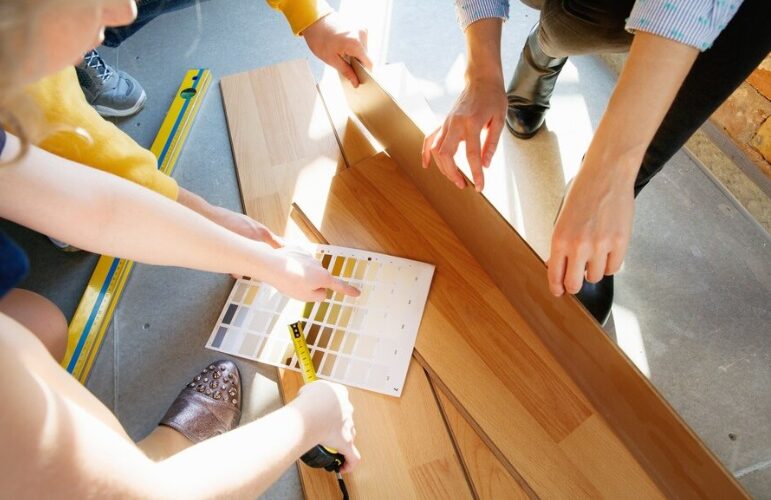Creating a unique look in your home can be both exciting and challenging, especially when it comes to selecting hardwood flooring. Many homeowners now opt for a mix-and-match approach to achieve a personalized aesthetic. This method can reflect your style while ensuring that your floors are functional and beautiful. The selection of different hardwood types and styles can make a significant difference in your overall interior design, allowing for both flair and cohesion. This article explores essential considerations and strategies for successfully mixing and matching hardwood flooring to elevate your home’s charm.
Understanding Different Hardwood Types
Before diving into creating a unique look, it’s essential to comprehend the various hardwood types available. Common types include oak, maple, cherry, and hickory, each carrying its unique characteristics and appeal. Oak is renowned for its durability and resistance to wear, while cherry displays a rich, deep color that enhances warmth. Maple’s lighter shade can brighten rooms, and hickory boasts a striking grain pattern that adds visual interest. When mixing these types, consider the hardwood’s grain pattern and color. For instance, combining oak and cherry can create a luxurious atmosphere, especially when done with intention. Selecting pieces that complement one another can create seamless transitions within your spaces.
Combining Styles for a Personalized Look
Beyond color and texture, the style of hardwood flooring should also guide your design choices. Various styles, such as rustic, modern, or contemporary, can influence how flooring types interact. For example, a rustic cabin-themed space may benefit from the bold grain of reclaimed wood, while contemporary homes may favor sleek, minimalistic designs. It’s essential to select styles that resonate with each other. Mixing a polished, modern oak with distressed hickory can create a stunning juxtaposition, inviting a sense of warmth and eclectic taste. Creating personalized looks helps set your home apart and makes your space uniquely yours. Consider exploring options at https://www.reallycheapfloors.com and other flooring product retailers to find a diverse range of hardwood flooring styles. This resource can provide insights into various types, styles, and colors available, enabling you to visualize potential combinations in your spaces. Accessing professional advice and samples can also help clarify how different hardwood types may blend in your particular environment.
Color Coordination: The Key to Harmony
Color coordination plays a pivotal role in achieving a cohesive look. When combining different hardwood flooring types, select complementary shades to maintain unity in your design. For instance, pairing a medium-toned oak with a slightly darker mahogany can bring depth while still highlighting the natural beauty of the wood. Avoid using floors that contrast too drastically, as drastic changes can create a disjointed appearance. In addition to tone, consider the finish on your hardwood floors. High-gloss finishes create a polished look, while matte finishes offer a more rustic feel. By harmonizing both color and finish, your mixed flooring selections can blend beautifully, creating a sophisticated environment.
Texture and Grain Variation
The texture and grain of hardwood floors are fundamental to establishing a unique aesthetic. While some homeowners prefer a uniform look, introducing varied textures can add significant interest to a space. For example, pairing smooth maple with the rougher texture of hickory can create a compelling contrast. This approach emphasizes the uniqueness of each flooring type and adds a tactile quality to the space. Moreover, the grain pattern can influence the perception of space within a room. Using wider boards alongside thinner ones can provide visual contrast and break the monotony of traditional flooring styles. This technique invites curiosity and allows your flooring to become a conversation starter, showcasing your design creativity.
Transition Spaces: Seamless Blending
When mixing hardwood floors, pay particular attention to transitions between different flooring types. Transition spaces—areas such as doorways or open floor plans where two types of flooring meet—must be seamlessly blended to avoid visual interruption. Use transition strips or thresholds that complement both flooring types for a polished finish. In open layouts, consider using different hardwood flooring types in distinct zones without harsh breaks. For instance, a living area might feature a warm hickory, while a dining area transitions smoothly into a lighter oak. Strategic placement enhances both function and aesthetics while allowing each style to shine.
Maintenance and Care Considerations
When opting for a combination of hardwoods, think about the maintenance involved. Each hardwood type has its specific requirements regarding cleaning, refinishing, and care. For instance, softer woods might dent more easily, necessitating more care compared to denser options. Additionally, varying finishes may require different cleaning products or methods. It’s wise to ensure your selected styles and types are compatible with your desired maintenance routine. This consideration prevents potential headaches later on, ensuring your investment in flooring maintains its beauty over time.
Expert Consultation: The Ultimate Guide
Consulting with flooring professionals can elevate your choices to another level. These experts provide invaluable insights into design trends, installation, and mixing methods, helping you find the perfect balance in your unique hardwood floors. Additionally, a professional can assist in ensuring that your selected flooring types are compatible in terms of durability, wear, and maintenance. Taking the time to explore your options and work with professionals enhances the likelihood of a stunning final result. Your design vision can flourish with the right expertise backing your selections, resulting in a home that reflects your individuality.
Mixing and matching different hardwood flooring types presents an exciting opportunity to personalize your home. By understanding the various types, considering texture, and color coordination, and seeking professional advice, you can create a space that resonates with your style. Focus on seamless transitions and the harmonious blending of different styles to achieve a distinctive, aesthetic appeal that enhances your living environment.
